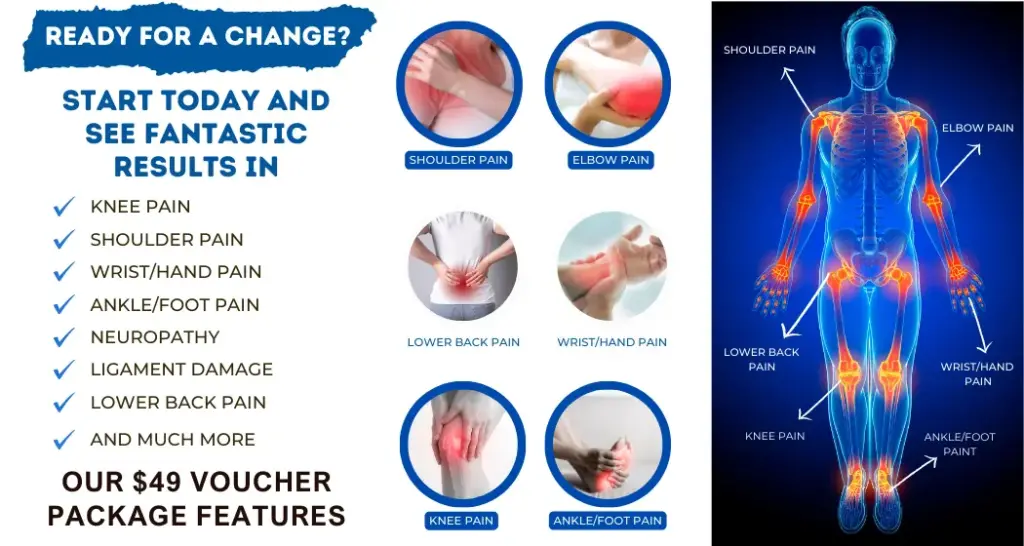Trigger point therapy is a unique form of treatment aimed at addressing musculoskeletal pain through the release of tension in specific sensitive areas known as trigger points. This therapy can involve various techniques such as massage, injections, or dry-needling, with the goal of alleviating pain and improving overall functionality. The therapy targets not just the site of pain but also other areas that might refer pain to different parts of the body, thus emphasizing the interconnectedness of the musculoskeletal system.
Key Takeaways
- Trigger point therapy focuses on alleviating pain by addressing sensitive muscle fibers that cause referred pain throughout the body.
- The therapy can include manual pressure, vibration, injections, and is distinct from general pressure point massage.
- It targets the origin of pain, which may not always correspond with the area where the patient feels pain due to referred pain mechanisms.
- Patients should wear comfortable clothes and can take a more relaxed role during therapy sessions.
- Practitioners often integrate the therapy with other treatments to treat a variety of conditions, including sciatica, migraines, and fibromyalgia.
Understanding Trigger Point Therapy
Trigger points, often called ‘knots’, are tender areas typically located near muscle insertions, ligaments, or joints. These points can cause discomfort, stiffness, and pain, which may be localized or referred to other body parts. Trigger points are a significant factor in myofascial pain syndrome, a condition marked by chronic pain involving the fascia and muscle tissue.

Defining Trigger Points and Their Role in Pain
Trigger point therapy reduces pain by ‘releasing’ tension in fascia and structures. This restores normal movement, preventing tissue damage. The identification and treatment of trigger points are crucial because they can lead to a cycle of pain and muscle spasm. Consequently, the therapy involves techniques such as manual pressure, vibration, or injection to deactivate the trigger points, providing relief from both local and referred pain.
- Common Symptoms Associated with Trigger Points:
- Localized tenderness
- Referred pain
- Stiffness and restricted mobility
- Headaches or other sensations
Understanding the underlying causes of trigger point pain, such as scar tissue buildup or joint misalignments, is essential for effective treatment. This knowledge helps therapists and medical staff determine the best course of treatment for trigger points. Massage therapy is a good alternative, however if the patient is having more intense pain, or has had this problem for a longer period of time more aggressive treatments. This include trigger point therapy injections would be more beneficial. A medical professional with experience in injections, as well as joint and muscle function, needs to make this decision.
Comparing Trigger Point Therapy with Other Massage Techniques as well as Trigger Point injections.
Trigger Point Therapy (TPT) distinguishes itself from other massage techniques through its targeted approach. Unlike general massage that aims to promote relaxation and overall well-being, TPT focuses on deactivating specific trigger points to alleviate pain and dysfunction. These trigger points are sensitive spots in the muscle or connective tissue. When pressed, they cause pain and can also result in pain in other parts of the body.
Trigger Point Therapy is not just about applying pressure; the strategic intervention aims to address specific areas of discomfort and imbalance.
While traditional massage techniques may inadvertently affect these points, TPT employs a deliberate method, often involving sustained pressure, which can include manual pressure, vibration, or even dry-needling. The table below compares key aspects of TPT with other massage techniques:
| Aspect | Trigger Point Therapy | Other Massage Techniques |
| Focus | Specific trigger points | General muscle groups |
| Pressure | Sustained and targeted | Varies, often lighter |
| Goal | Alleviate pain, improve function | Promote relaxation, well-being |
| Techniques | Manual pressure, vibration, dry-needling | Kneading, stroking, tapping |
Understanding the nuances between TPT and other forms of massage is crucial for individuals seeking relief from chronic pain or muscle tension. Moreover, by tackling the root cause of pain at its source, TPT can offer a more focused and often more effective solution for pain management.
If results are not being achieved through trigger point therapy massage, an incredibly beneficial approach is trigger point injections. These injections are performed by a health care professional, who inserts a small needle into the patients trigger point. The injections contains a local anesthetic, saline or a homeopathic solution. With the injection, the trigger point is made inactive and pain is alleviated. Often only a brief course of treatment is needed to fully dissolve the trigger point and decrease the pain, inflammation, and muscle spasms. Additionally, the injection is given in the doctor’s office and only takes a few minutes. Furthermore, several sites may be injected in one visit.
At Waters Edge Medical Clinic and Spa we perform trigger point injections to help alleviate pain, discomfort as well as muscle spasms. In our clinic, we focus on natural pain relief and regeneration, using only natural products. This approach helps to reduce the harmful side effects associated with corticosteroid injections.
Science Behind Myofascial Release
Myofascial release is a method that focuses on the fascial tissue, which envelops muscles and organs throughout the body. When fascia becomes tight or restricted, it can lead to pain and limited mobility. By applying gentle, sustained pressure to these areas, therapists aim to release the tension and restore normal function.
The effectiveness of myofascial release is not only anecdotal; it is supported by various therapeutic approaches. For instance, instrument assisted soft tissue mobilization and foam rolling are techniques that have been proven effective in treating Myofascial Trigger Points. These methods complement the hands-on approach of myofascial release, offering a spectrum of options for personalized care.
Myofascial release is a key component of a comprehensive treatment plan, addressing the complex interplay between muscles, fascia, and body mechanics.
Understanding the intricate anatomy and physiology of fascial tissue is crucial for therapists. Advanced training in areas such as biomechanics, kinesiology, and functional anatomy is essential to effectively assess and treat myofascial dysfunction and trigger points.
The Benefits of Trigger Point Therapy
Trigger point therapy is a powerful tool for those suffering from chronic pain and seeking to improve their mobility. By targeting particular areas of muscle tension, this therapy can provide significant relief and enhance overall movement.
Alleviating Chronic Pain and Improving Mobility
Chronic pain often leads to a vicious cycle of immobility and muscle stiffness. Trigger point therapy alleviates pain and discomfort, often times a combination of treatments including trigger point injections plus trigger point massages help diminish and eliminate trigger points allowing the body to function normally through increased range of motion. The aim of trigger point therapy is not only to ease pain but also to restore the body’s natural ability to move freely without any discomfort.
Conditions commonly addressed by trigger point therapy include:
- Auto Accident Injuries
- Back and Shoulder Pain
- Headaches
- Herniated Discs
- Repetitive Use Injuries
Patients can anticipate a gradual improvement in their condition, with each session contributing to a cumulative effect that promotes long-term health and mobility.
Conditions and Symptoms Addressed by Trigger Point Therapy
Trigger point therapy is a versatile treatment that addresses a wide range of conditions, often providing relief where other methods may fall short. Chronic pain and muscular dysfunction are primary targets for this therapy, with patients experiencing improvements in both comfort and function.
- Sciatica
- Carpal tunnel syndrome
- Migraines
- Tennis or golfer’s shoulder
- Osteoarthritis
- Fibromyalgia
- Plantar fasciitis
These conditions, among others, can benefit from the focused pressure and manipulation used in trigger point therapy. It’s designed to alleviate the discomfort associated with these ailments, restoring a sense of well-being and movement.
Trigger point therapy aims to alleviate tension and stress in the fascia and other structures in specific areas, thereby restoring normal movement and easing pain.
Integrating Trigger Point Therapy with Other Treatments
Trigger Point Therapy (TPT) is often used in conjunction with other treatments to enhance overall pain management and recovery. Integrating TPT with other modalities can address multiple facets of pain and dysfunction, offering a more comprehensive approach to healing.
- Chiropractic Adjustments: Aligning the spine can reduce the stress on muscles, making TPT more effective.
- Physical Therapy: Combines exercises and TPT to improve mobility and strength.
- Acupuncture: May complement TPT to target pain relief and promote energy flow
- Regenerative medicine: help regenerate affected tissue allowing for normal cellular growth and repair.
By considering the body as a whole, therapists can create a synergistic treatment plan that leverages the strengths of each modality. This holistic approach often results in more significant improvements in patient outcomes. t’s crucial to discuss all the treatments you’re receiving with your healthcare provider. This ensures coordination of your care and that therapies complement rather than counteract each other.
Preparing for Your Trigger Point Therapy Session
To ensure you get the most out of your trigger point therapy session, it’s important to come prepared. Comfortable clothing is key, as it allows for unrestricted movement and access to areas where trigger points may be located. Opt for loose-fitting garments that don’t constrict your body or impede your therapist’s ability to work on your muscles.
What to Wear and How to Set Up for Success
In addition to clothing, setting up for success involves a few simple steps:
- Arrive a few minutes early to fill out any necessary paperwork and to relax before your session.
- Hydrate well before and after the therapy to help your muscles recover and to flush out toxins released during the treatment.
- Be open with your therapist about your pain levels and any specific areas of concern.
Keep in mind that the aim of trigger point therapy is to relieve pain and enhance function. Therefore, setting up a conducive environment for your session is essential for achieving optimal results..
Understanding the Patient’s Role During Therapy
During trigger point therapy, the patient’s role is crucial for the success of the treatment. Active participation and communication are key; patients are encouraged to provide feedback on their comfort levels and the intensity of the therapy. This collaborative approach guarantees that the therapy is tailored to individual needs and pain thresholds.
- Stay informed: Understand the goals and methods of your therapy.
- Be communicative: Share any discomfort or preferences with your therapist.
- Follow guidance: Adhere to any pre-session instructions, such as hydration or attire.
It’s important to remember that your input can significantly influence the outcome of your therapy. Being open and honest with your therapist will contribute to a more effective treatment plan.
Initial Consultation and Medical History Review
Upon arriving for your initial consultation, you will be greeted by a physical therapist who will guide you through a comprehensive patient history questionnaire. This step is crucial for tailoring the therapy to your specific needs and conditions. You’ll also undergo a physical examination to evaluate areas of concern and establish a baseline for your treatment plan.
Before the session, it’s important to complete any required forms, which may include patient information, insurance details, and medical history. Here’s a checklist to ensure you have everything ready:
- Patient Info / Forms
- Direct Access
- Insurance Info
- Doctor Referral
- Review Us
During this initial phase, feel free to ask questions and express any concerns. It’s an opportunity for you to become an active participant in your healing process.
Remember, the goal of this first visit is to create a personalized plan that may incorporate various therapeutic exercises, joint mobilizations, and other evidence-based treatments.
The Trigger Point Therapy Process
Trigger point therapy encompasses a variety of techniques aimed at alleviating the discomfort associated with trigger points. At Waters Edge medical Clinic and spa, we will conduct a thorough medical exam and evaluation.
Techniques Used by Therapists to Release Tension
Once we establish the severity of the problem, a treatment plan will be recommended. Often times treatments will include trigger point injections to alleviate trigger points, pain, and muscle spasm. Other therapies may also be recommended including Soft Wave therapy, Red light therapy and even regenerative medicine. These modalities working together will help ease pain, tension and promote the body’s natural healing processes. Trigger point therapy is not just about applying pressure; it’s about restoring normal movement and relieving pain to reduce the risk of further tissue damage.
What to Expect During a Session
When you arrive for your trigger point therapy session, you’ll be guided through a series of steps to ensure the treatment is tailored to your specific needs. Initially, you will be asked to provide a detailed medical history to assess any potential risks or contraindications for therapy.
The session itself involves a combination of therapies plus trigger point injections. The medical staff will focus on areas of muscle and fascia believed to harbor trigger points, inserting a small needle and injecting to help dissolve the affected trigger point. They will use a cooling spray, eliminating the pain and discomfort of the procedure.
After the session, you may experience immediate relief, or it may take a few sessions to feel significant changes. Your medical team will provide post-therapy care instructions and may suggest exercises or stretches to do at home.
Post-Therapy Care and Recommendations
After a trigger point therapy session, it’s crucial to give your body the necessary time to recover and respond to the treatment. While most patients can return to their daily activities within a day, we recommend a gradual return for optimal healing.
It is essential to maintain hydration post-therapy. Water facilitates the healing process and enhances the benefits of the therapy. Aim to consume a significant amount of water relative to your body weight, especially if you’re physically active.
In addition to hydration, consider the following post-therapy care tips:
- Stay engaged in any prescribed physical therapy exercises.
- Refrain strenuous activities for a couple of days.
- Monitor your body’s response to the therapy and report any concerns.
Remember, the path to recovery is a partnership between you and your therapist, and following these recommendations can lead to more effective and lasting relief.
Conclusion
In summary, trigger point therapy emerges as a promising approach to managing and alleviating musculoskeletal pain without resorting to surgery. By targeting sensitive trigger points through various techniques such as massage therapy, injections, or dry-needling, this therapy aims to release muscle tension and mitigate referred pain. Before undergoing this therapy, individuals should consult a qualified healthcare provider to gain a comprehensive understanding of its potential benefits and to ensure they are adequately prepared for treatment sessions. With its focus on restoring normal movement and reducing the risk of further tissue damage, trigger point therapy holds the potential to offer significant pain relief and enhance overall quality of life for individuals grappling chronic pain conditions.
Frequently Asked Questions

What exactly is trigger point therapy?
Trigger point therapy is a form of treatment that aims to alleviate musculoskeletal pain by deactivating sensitive areas known as trigger points. These areas can induce pain locally or referred pain, and the therapy may involve techniques like massage, injections, or dry-needling to release muscle tension and relieve pain.
How does trigger point therapy differ from traditional massage?
Unlike traditional massage that may focus on general relaxation and tension release, trigger point therapy specifically targets trigger points that are contributing to pain and discomfort. It uses precise pressure and techniques to release these points, which can alleviate referred pain and improve mobility.
What conditions can trigger point therapy help with?
Trigger point therapy can be effective for a variety of conditions including sciatica, carpal tunnel syndrome, sports injuries, tinnitus, osteoarthritis, migraines, tennis or golfer’s shoulder, post-surgical pain, plantar fasciitis, and fibromyalgia, among others.
How should I prepare for a trigger point therapy session?
Before a trigger point therapy session, wear comfortable clothing and sturdy shoes. While some physical therapy requires active participation, trigger point therapy often allows you to take a more passive role, but comfort and ease of movement are still important.
What can I expect during a trigger point therapy massage session?
During a session, a therapist will apply pressure to the trigger points to break up clusters of waste products causing pain. You may experience varying levels of discomfort as we treat these areas, but our goal is to release tension and ease symptoms.. An initial consultation will include a medical history review to ensure the therapy is safe for you.
What can I expect during a trigger point therapy injection?
Before performing a trigger point injection, we will cleanse the area using an aseptic technique. A small needle with a small amount of medication, such as Traumeel which is a homeopathic anti-inflammatory or even regenerative medicine treatments like Platelet rich plasma therapy (PRP) will be injected in the affected trigger point. This will help eliminate the trigger point and relieve pain and muscle spasms.
What are the benefits of integrating trigger point therapy with other treatments?
Integrating trigger point therapy with other treatments can enhance pain relief and recovery. It can address referred pain from other parts of the body, release tension in the fascia, and minimize the risk of further tissue damage, making it a valuable complement to a comprehensive treatment plan.
If you have any additional questions or feel that you may be suffering with problems that could possibly be associated with trigger points, feel free to contact Waters Edge Medical Clinic and Spa to schedule your free consultation and evaluation. You can reach us at 727-550-0855.


